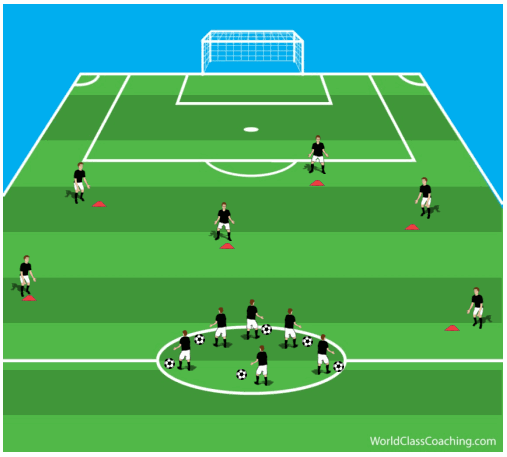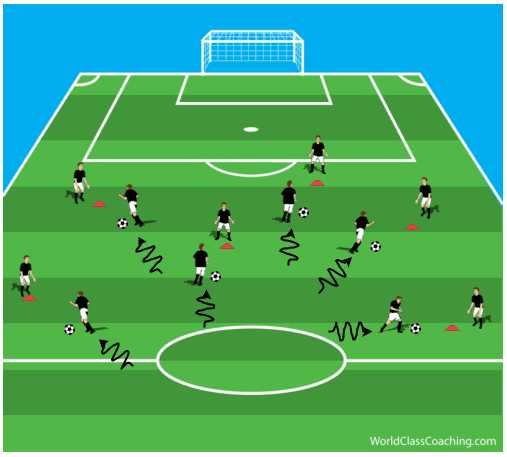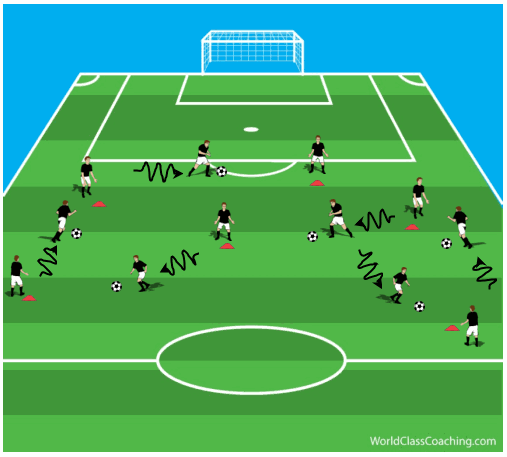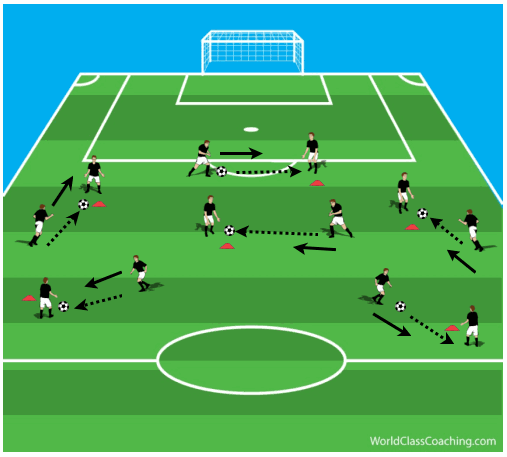By Justin Cresser
Today’s activity is a simple exercise that develops Aerobic Endurance while working on dribbling, passing and receiving techniques. One of the good things about this drill is that it can also be used as a warm-up routine. If you do decide to use it as a warm-up activity, ensure that you incorporate dynamic stretches for the major muscle groups (hamstrings, quadriceps, etc.) during the rest periods between repetitions.
This activity uses the space between the halfway line and the top of the 18-yard box for the playing area. Divide your squad into two equal groups. Lay out several cones (the number of cones will be equal to the number of players in each group) across the playing area at random. However, each cone should be at least 10 to 15 yards from the nearest cone. For the purpose of this article, let us assume each group has 6 players; we have therefore placed 6 cones across the playing area.
Have all the players in one group stand inside the centre circle with a ball each. Have each player in the second group stand behind a different cone (Figure 1).

When ready, direct the players in the centre circle to dribble at speed towards a different player standing by a cone (Figure 2). Each person must choose a different player to dribble to and therefore emphasizes decision-making ability.

As soon as the dribbling player reaches the cone, they should stop the ball at the feet of the standing player, who will then dribble as quickly as possible towards a player standing at a different cone (Figure 3).

Continue this process for 90 seconds and then have the players rest actively for 60 seconds by walking around the playing area. Repeat this process for another 2 repetitions. However, vary the dribbling component for each sequence by having the players perform a specific skill (step-over, etc.) while dribbling.
After a few repetitions, incorporate a passing and receiving component into the drill by making the following adjustment: When the players are approximately 5 yards away from the person they are dribbling towards, have them play a firm pass to that player’s feet and then take the player’s spot at the cone (Figure 4).

As soon as the player standing at the cone receives the pass, they must dribble towards a player standing at any of the cones around the playing area. As before, they should make a pass to the player standing at the cone when they are approximately 5 yards away and then take that player’s spot. Continue this for 90 seconds and then rest for 60 seconds.
For the last 1 or 2 90-second sequences, have the player SPRINT to the cone after making the pass to the other player’s feet. Complete a total of 6 to 8 repetitions.
Variations:
You can vary this drill in many ways. As mentioned above, you can have the players perform different fakes or skills when dribbling. You should also vary the receiving element of the drill by having the players use both the inside and outside of the foot when taking their first touch into space. Finally, you can have the players perform a double pass before the player receiving the ball dribbles to a new cone.
Coaching Points:
- Encourage your players to dribble as quickly as possible but under control.
- When dribbling, the players should take soft touches while keeping their heads up. They should also use both feet and different surfaces of the foot to play the ball.
- In the passing and receiving component, emphasize firm and accurate passes on the ground. In addition, the player receiving the pass must take their first touch into space.
- During the passing component, you will frequently observe two players passing to the same person. As such, players must use both verbal and visual communication to ensure that this situation does not occur.
Justin Cresser – Has coached soccer at various levels both in North America and abroad (Hong Kong and Africa). His most recent position was as the Assistant Technical Director at the Soccer Club of Toronto. He has his National Diploma from the NSCAA and is also a certified strength and conditioning coach.


